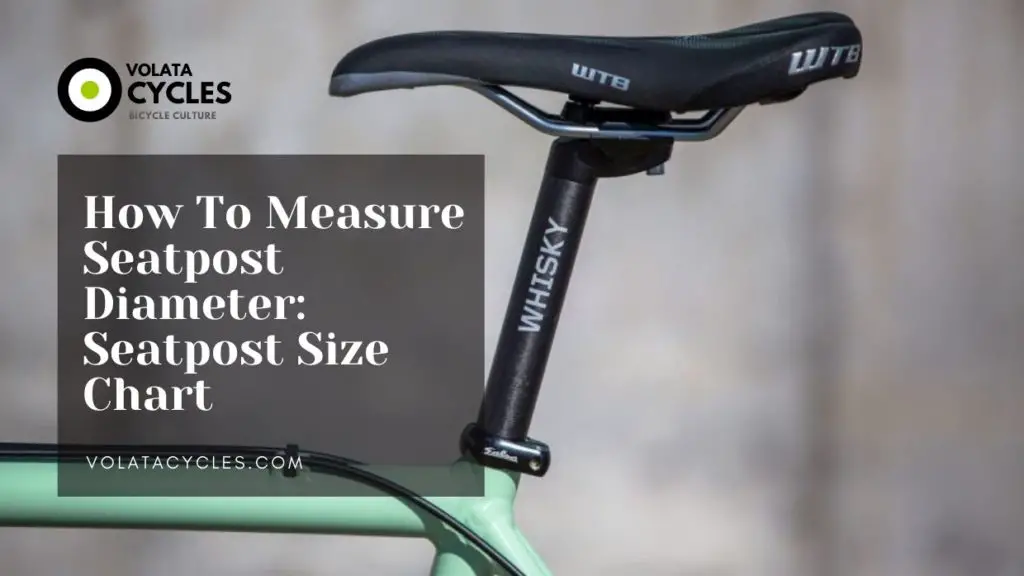There are a lot of things to think about when you want to buy a new seatpost. But how do you know how to measure the diameter of the post?
A good post makes your ride more comfortable and can make your bike faster. The seatpost is one of the most important bike parts. Installing an incorrect size can damage your frame, and it can also cause back pain.
But you don’t need to worry about this – we have written a step-by-step guide that will show you how to measure your seatpost so that it fits on your bike!

What Is the Ideal Seat Post Size?
You can check your existing or previous saddle post to figure out the seat post size. This is the simplest method to measure the size of your dropper. It may appear obvious, but it’s worth noting that you can determine the diameter of a seat post by looking at your current or old saddle post.
If you don’t know the length of your current seatpost, you should remove it and measure it. The most popular sizes are generally stamped, or laser etched near the end of the insertion line.
Because of age and friction, the marking may be rubbed away. So, how do you figure out how big your dropper is? This is when we get hands-on and take measurements. You can measure the size of the post with a digital caliper and metric calipers to see if the present seatpost’s diameter is correct.
If you have an old saddle-post that is securely fastened, measure its outer diameter for an accurate idea of what you’ll need to purchase. However, suppose the old seat-post is worn down, and you cannot make reasonable predictions from it. In that case, you must proceed to the next step, where we will show you how to measure the seat tube diameter.
Standard seatpost diameters
| 21.15 | 25 | 26 | 27 | 28 | 29 | 30 | 31 |
| 22 | 25.4 | 26.2 | 27.2 | 28.6 | 29.2 | 30.2 | 31.2 |
| 22.2 | 25.5 | 26.4 | 27.4 | 28.8 | 29.4 | 30.4 | 31.4 |
| 23.4 | 25.8 | 26.5 | 27.7 | 29.6 | 30.8 | 31.5 | |
| 23.8 | 26.6 | 27.8 | 29.8 | 30.9 | 31.6 | ||
| 24 | 26.8 | 31.8 | |||||
| 32 | |||||||
| 34.9 |
Seatpost diameters are usually a multiple of 0.2mm, but not always. If you measure something close to a number that is not a multiple of 0.2, the next higher size will most likely fit. For example, if you measure 25.5mm wide seatpost and find out that the next size is 27mm, it will most likely fit.
The right post is the one that slides in without being forced (other than by hand) and does so freely. The seatpost is likely too narrow if it drops in with play before the pinch bolt is tightened.
| 25 | 26.8 | 27 | 28.6 | 30.9 | 31.6 | 34.9 |
| 25.4 | 27.2 | 31.8 |
Table 2 summarizes the most popular seatpost diameters utilized on modern bicycles (from the mid-nineteenth century to now).
How to Measure Seat Tube Diameter: The Right Method
The seat tube is a structure that supports the seatpost. To put it another way, it’s where you attach the seat post. When measuring the seat tube, make sure to measure the inner diameter of the area where the seat post will be inserted. Do not measure the external diameter since this does not contribute to determining the size of the seatpost.
The diameter of the seat tube is measured using a Vernier caliper. When measuring both external and internal elements, a Vernier caliper is extremely accurate. You may get digital readouts for calipers that you can switch between metric and inch at the press of a button.
External or Internal Routing
Internal or external cable routing of the seat-posts is a matter of personal preference. Internal cabling (also known as stealth) is the most popular type of mountain bike wiring. Internal cable routing connects the seatpost to the remote control at the shaft of the post. On the other hand, external cable routing entails routing cables on the outside of the seat tube, usually on top.
The size you get from your post will be determined by the routing of the cable. I recommend going for a seat post with the wire routed to the shaft rather than the head. This makes it less vulnerable to damage and looks great aesthetically.
Length of the Dropper
The length of the dropper is the next major aspect to consider when selecting a seat post. When the post is fully extended, the length of the dropper is always measured.
The comfort and efficiency of your ride will depend on the amount of “drop” you require. The vast majority of bikes come with a limit of 100 to 150 mm. It’s good to get as much travel as possible. This implies that you have complete control over your seat’s position and can decrease it for added comfort and fun.
Maximum Extension
To measure the seat post correctly, first figure out how high you want your seat to be when fully extended. To do so, measure the collar to the center of the seat rail. You don’t want a post to be too long because it might reduce power transmission and efficiency while cycling.
Minimum Insertion
What is the maximum depth you can put your seatpost into the frame? You may measure from the top of the saddle collar down to where you believe there is no more room. It’s critical to understand how deep it goes because it’ll keep you from focusing on extension numbers that might deceive you and make it difficult to lower your post.
Overall Length
When determining the dropper’s size, keep in mind that the overall length is crucial. Seatposts come in different lengths, so be sure you get one that suits your needs. A short post might be uncomfortable and ergonomically incorrect. The most common Seatpost length ranges between 75 millimeters and 400 millimeters.
The shortest seatpost are sometimes lightweight, but they are less adjustable. Longer seatposts are more flexible. Most mountain bikes feature longer seatposts that make it easier to change them for uphill and downhill surfaces, making them secure and allowing you to avoid harm.
Sizing Rod
To find the size of your seat post, you can use a rod. You put the rod inside the tube and match it to the diameter. The rods are different sizes, so you can stop when you meet one that fits. The correct reading is at the end of the tube.
FAQ
What is Raleigh’s seatpost size?
Raleigh seatposts are usually made of aluminum, which is lightweight and strong. Raleigh seatposts come in different diameters. The standard diameter for the Raleigh seatpost is 27.2 millimeters.
Are all seat posts the same size?
No, seat posts vary in size and how much they can be dropped. The seat post diameter is not always how much it can be dropped and how long it is. You need to measure how deep the seat post goes down and how far down the seat post extends.
Seatpost diameters vary from 22 to 35 millimeters in 0.2 mm steps. The most popular size is 27.2 mm (1.07 inches), used on most bikes, especially high-quality versions. Larger diameters such as 30.9 mm are utilized in some modern bicycles with thicker aluminum or carbon tubing for strength.
Can I put a longer seatpost on my bike?
Sometimes you can. I installed a longer seat post on my mountain bike, but it did require some modifications to the bicycle frame. If you aren’t comfortable with doing this, make sure to get a seat post of appropriate length which will allow you to change how high your seat is positioned for comfort and efficiency.
What is a layback seatpost?
A layback seatpost is a type of bicycle part designed to replace the traditional howitzer-style seatpost. It is similar to howitzer posts, but it features a layback design, which means that the rider sits back on the bike instead of sitting upright. Layback seats are usually found on mountain bikes. They are most familiar with 26″ frames because this size is noticeably shorter than 29″ or 27.5″ bicycles.
What is trek bike seatpost size?
Trek bike seatposts come in two different sizes: 27.2mm x 300mm x 40mm and 31.6mm x 350mm x 40mm. The 27.2 mm seatpost is the most common size and is typically found on high-quality bicycles.
Are suspension seatposts any good?
Suspension seatposts can help you be more comfortable on your bike. They smooth out rough and bumpy roads and can even help prevent back injuries. Many contraptions have been created to help people be more comfortable on their bikes. Still, many of them were not as popular as suspension seatposts.
Final Words
The seatpost is one of the most overlooked bike components. Choosing the incorrect size not only damages the frame but can also lead to back pain.
We have prepared this how-to guide that will show you how to find out how deep it goes so you keep from focusing on extension numbers that might deceive you and make it difficult to lower your post.
